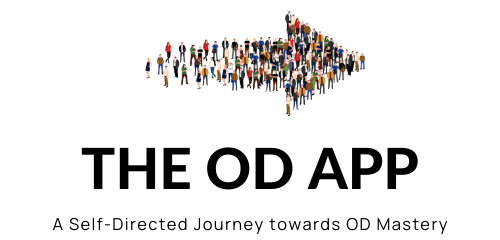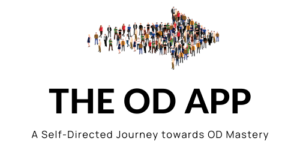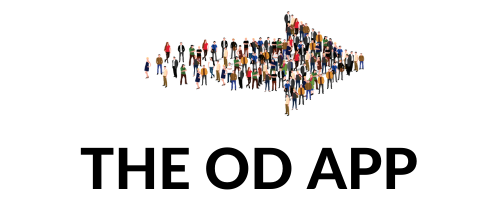Part 1 – My Journey into Organizational Design
My journey into organization design accelerated when I worked for British Airways (1996–2001) as an internal consultant. One of my colleagues there was interested in organization design and ran a couple of programmes for the consulting teams. Without fully realizing it, I’d been heading into the design direction for probably 15 years. My first career was in adult education and from there I moved into managing learning and development functions, but came to the conclusion (maybe contentious?!) that learning and development on its own does not necessarily lead to organizational change, although it may be of great benefit to the individual, or to groups of individuals (as in team development).
You’ve probably all experienced leaving a course on a high, with all sorts of intentions of doing things differently back in the workplace, only to be stymied by systems, structures, policies, controls, and all the stuff that makes organization design. (Sometimes described as the ‘formal elements’, with learning, development, culture, and behaviours as the ‘informal elements’).
Thinking that organizations change only when there is a combination of intentional shaping of both the formal and informal elements of them, I got interested in systems and did a couple of Open University courses in systems approaches. One I recommend now is the Post Graduate Diploma in Systems Thinking in Practice https://www.open.ac.uk/postgraduate/qualifications/e28.
Part 2 – What Organizational Design Is
Systems were part of my interests, but a process and framework for applying systems change into the design work wasn’t there until the British Airways courses, which taught a methodical project-based approach to doing design work.
A methodical approach is necessary as, even with one, organization design is messy and unpredictable work. It is not about organization charts but about organizations as complex, adaptive systems. It is about the intention to design a better organization. There are multiple definitions of the term Organization Design, each giving a slightly different take on what it is:
- Practitioner and academic Nicolay Worren, in his blog ‘What is organization design?’ says that OD means more than ‘boxology’, involving ‘the creation of roles, processes, and structures to ensure that the organization’s goals can be realized’.
- The Center for Organizational Design says, ‘Organisational design is a step-by-step methodology which identifies dysfunctional aspects of work flow, procedures, structures, and systems’.
- McKinsey describes Organization Design as ‘going beyond lines and boxes to define decision rights, accountabilities, internal governance, and linkages’.
- The European Organisation Design Forum (EODF) defines it as a ‘systematic and holistic approach to aligning and fitting together all parts of an organisation to achieve its defined strategic intent’ (https://www.eodf.eu/).
- The definition of Organisation Design that I use is ‘intentionally arranging people, work, and formal organizational elements to effectively and efficiently achieve a business purpose and strategy’.
What all these definitions have in common is that they view an organization as a system, comprising interdependent elements that collectively work to deliver a purpose.
The fact that there is no one definition means there is no single framework for doing Organization Design, and no standard and agreed-upon set of competences for practitioners. Indeed, there are several related disciplines that claim Organization Design as their remit: business architects, enterprise architects, service designers, HR practitioners, systems architects, enterprise designers, operating model developers, business process engineers, and so on. Each view Organization Design through their particular lens, and several have career- and skills-development routes via certifications and/or competence frameworks that recognise both technical expertise and the business strategy interdependence, as well as the skills and knowledge typically needed to practice Organization Design through the specific lens of the discipline.
Accepting that organizations are systems and that systems thinking helps in design work, enables designers ‘to step back from the system they are in, think about what they are trying to achieve in relation to the bigger picture, and to collaborate with a broad range of stakeholders … encouraging them to assess and question the existing system – the boundaries, perspectives, and relationships that could be relevant to addressing their design issues and opportunities.
Note that systems thinking includes thinking about the culture, behaviours, informal elements and, more specifically, how the formal elements are instrumental in shaping these (and vice versa). It is not possible to do Organization Design work without doing organization development work, although it is possible to do organization development work without doing Organization Design work – but it may not be as effective as hoped. See my blog on the relationship between organization Design, organization development, and change management here: https://naomistanford.com/2017/01/16/the-relationship-between-organisation-development-change-management-and-organisation-design/
The field history of Organization Design is problematic and contested partly because it depends on what we mean by Organization Design. Another of my blogs discusses this question: https://naomistanford.com/2018/09/17/agreeing-what-organisation-design-means/
Suffice it to say that we are moving from descriptors of organizations as mechanical systems and pyramid hierarchies (the language of pulling levers, triggers, chains of command) that can be manipulated – towards descriptors of organizations as networks, collaborations, and complex adaptive systems that ‘emerge’ – and can only, perhaps, be shaped. This is challenging many of the assumptions traditionally held about Organization Design, as the following table illustrates.
The table is adapted from the article, ‘Emerging Assumptions about Organization Design, Knowledge and Action’ by Alan Meyer. https://papers.ssrn.com/sol3/papers.cfm?abstract_id=2379976
| Established Assumptions | Emerging Assumptions |
| Organization Design is about organization charts. | Organization Design is about systems and processes. |
| Organization designs should be hierarchical structures supported by organizational processes that control members’ behaviour. | Organization designs should emerge from ‘design thinking’ and principles that generate empathy with users. |
| Designers should create structures and processes that ensure control, create stability, and absorb uncertainty. | Designs should set in motion novel actions in pursuit of novel goals. |
| Designs should be developed by leaders. | Designs should be developed through involvement of people who do the day to day work. |
| Design work is a spasmodic event. | Design work is a continuous process. |
Part 3 – Organizational Design Competencies
Dr L Mee-Yan Cheung-Judge describes competencies as ‘the characteristics that define successful performance by a professional practitioner. It delineates who practitioners need to be, what they need to know, and what they must be capable of doing. It is a detailed description of an ideal performer.’
The Organizational Design Community certifies practitioners https://orgdesigncomm.com/Certification-Program on evidence of practical experience. It does not list required competences.
The UK’s Chartered Institute of Personnel and Development (CIPD) has an HR Profession Map with one of the specialisms being ‘Organisational Development and Design’: https://peopleprofession.cipd.org/profession-map/specialist-knowledge/organisational-development-design. This is at four levels and, rather than competences, states ‘what you’ll understand’ by category at each of the levels. For example, at the Associate level you’ll understand ‘Macro trends that impact the design of organisations (e.g., sustainability, geopolitical, demographic, technology)’.
I don’t know if you can get to a ‘detailed description of an ideal organization design performer’, as the work requires different competences in different contexts and situations. My view is a range of what I call ‘professional skills and knowledge’ that are required, and also having certain personal attributes that are hallmarks of successful Organization Design practitioners.
Professional skills and knowledge includes systems theory, programme management, consulting skills, process mapping, and value stream analysis. Personal attributes include critical thinking and curiosity. I read somewhere about the necessary attributes for a diplomatic ‘objectivity and scepticism’, and those qualities seemed apt for organization designers. Maybe the skillset for design and diplomacy is similar? Designers also require the ability to wield credible influence – all too frequently internal organization designers are in a more junior position than people they are aiming to advise; and their skills, knowledge, and experience are sidelined. External Organization Design consultants typically do have credibility and influence but are not familiar enough with the organizational context to execute/implement the design. More successful design work blends external and internal expertise.
Fred Nickols takes a different tack on competences required of an OD consultant by asking, ‘What kind of an OD practitioner are you?’ (What Kind of OD Practitioner Are You) Rather than differentiating between change management, Organization Design and organization development, he collectively calls the three ‘OD’ (without specifying what the ‘D’ represents) and presents a framework for categorizing four basic kinds of practitioner: ‘The framework, a 2×2 matrix, arrays hard vs soft OD against the locus of the practice: that is, internal or external’. In his framework, ‘hard’ approaches refer ‘to the socio-technical stream of OD, including Organizational Design, process design and improvement, work design and redesign, and large-scale change management’ (Nickols, 2014).
‘Soft’ approaches refer to ‘the classic tools: team building, group facilitation, conflict management, etc’. Nickols then offers an additional distinction between ‘OD practitioners who focus on people and those who focus on the organization’. He has developed a grid on which the stars represent various kinds or styles of OD practitioners. He tells us to ‘note that all are stars; no one kind of OD practitioner is suggested to be better or worse than another’. My book, Organization Design: The Practitioner’s Guide, has a lot more information on practitioner skills, attributes, and roles.
Part 4 – Organizational Design Learning Paths
In terms of where people can develop Organization Design professional and personal skills and knowledge, I’ve taken many learning paths around Organization Design. You can read about some of them here: https://naomistanford.com/2019/06/17/learning-for-organisation-design/
In general, I’ve found that there are three ways to learn about Organization Design:
- Browsing
- Trying out
- Asking others
Browsing
Look at the Design Research Society website: https://www.designresearchsociety.org/cpages/home. It is the ‘multidisciplinary learned society for the design research community, promoting excellence in design research globally.
- Recognising design as a creative act common to many disciplines
- Understanding research and its relationship with education and practice
- Advancing the theory and practice of design
You’ll see how Organization Design is one strand of ‘design’. There are many facets of design, generally, most of them related to Organization Design in some way. Think about what slant (in the organization design field) you are specifically interested in and why you might be interested in it. If I were starting over, I might ask myself: Is it business design? Is it design innovation? Is it culture design? Is it socio technical systems design?
Many MBA programmes have an organization design-related module. (I taught on the California College of the Arts Design Strategy MBA). Radboud University has a Master’s specialisation in Organisational Design and Development.
Other sites to browse include:
- The Organization Design Forum (ODF), which has conferences, runs webinars and discussion events, and has a list of practitioners that do organization design training
- The European Organisation Design Forum, which accredits programmes, runs conferences, hosts networking events, and operates a mentoring scheme
- The USC Marshall School of Business, which offers an Organization Design Certificate
- The Organizational Design Community (ODC), which has an annual conference on design-related topics and publishes the Journal of Organization Design. In addition, it has established an accreditation programme.
Trying things out
If you’re not sure what aspect of Organization Design you’re interested in, there are some short (and free) online courses. Coursera® offers Design Thinking for Innovation (a few hours a week for five weeks). Also, their Competitive Strategy and Organization Design Specialization looks like great fun – and promises laughter along the way. The module Strategic Organization Design is six weeks of study, with 5.5 hours a week; or look at Leadership through Design Innovation, which looks at a ‘new style of leadership to embolden and accelerate innovation. [For which] design offers a novel way to discover market opportunities, experiment to validate concepts and mitigate risk, and deliver value to all stakeholders’.
FutureLearn (University of Twente.) offers Philosophy of Technology and Design: Shaping the Relations Between Humans and Technologies. (I have registered for this one.) And also, Designing the Future.
edX offers Design Practice in Business.
All of the above are drawn from university curriculums.
Asking others
There are several groups on LinkedIn that discuss Organization Design. Those I follow include the:
- Organizational Design Community
- Organization Design Forum (ODF)
- Organisation Design Network
- BetaCodex Network
- eOffice Workplace Design Community
- Association for Strategic Planning
- Design Thinking Group.
You could ask your questions and see what they come up with. If you go to any Organization Design networking events, ask people how they developed their skills and knowledge.
During a week when I did this, I got a good range of responses including:
- Roffey Park’s short course Organisation Design in Practice
- Hult Ashridge short course Advanced Organization Design
- The CIPD Level 7 Advanced Award in Organisation Design and Development
- The Design Management Institute events
- The Cornell University two-day course Organization Design: A Foundational Course for Practitioners
- The Open School of Management module on Organization Design
In summary – browse the field of Organization Design, figure out what aspects interest you and why, try out some short courses before committing yourself to a longer programme, and ask around for what has worked for others.




